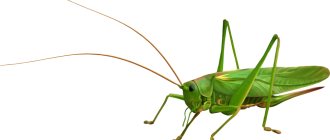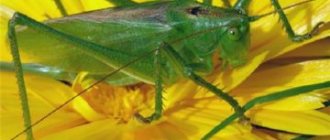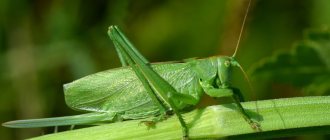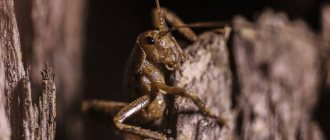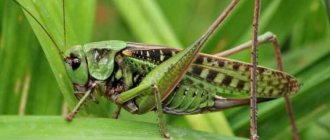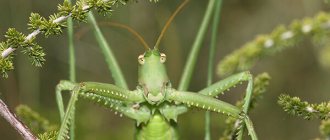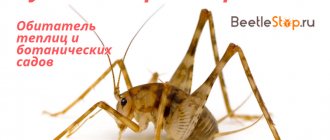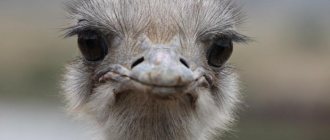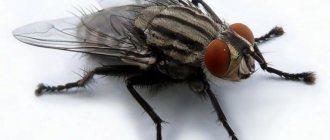The grasshopper photographs presented at Mikrul can be used as demonstration material in biology (zoology) lessons in 7th grade when studying the topic “Insects. Orthoptera."
What are the advantages of the photographs presented? In their clear image. If in a textbook for 7th grade the photographs are, as a rule, “separated” from the drawings (or diagrams) attached to them, so you have to constantly look from the drawing to the photograph and back, here everything is simpler. Firstly, the object is natural. Secondly, there is no need to run your eyes around (look for an explanatory text or diagram). Everything is nearby! Thirdly, on some slides there is also a magnification (120 times) of the organs being studied, which makes it easier to navigate through other frames.
We do not set ourselves the task of revealing the external structure as in-depth material. We simply give an explanation of where it is located and what this or that organ is. Why is that? When looking at a photograph (without a designation), naturally, as a rule, two questions arise: what is it and what is it called? Without receiving an answer to them, other questions naturally disappear, and along with them, interest in studying disappears. How does notation photography work? Let’s look at the example of the “Grasshopper Head” frame. The first thing your eye goes to is the lower right corner. This is where the attracting (currently unknown) object is located. But if “upper and lower lips” are somehow still clear (that this is a mouth), then what are “mandibles”? You are not interested in what the “mandibles” are made of, what they are covered with (or not covered with), what work (function) they perform, etc., all this comes later. In the meantime, the question is - what is it? Here under the photo is the answer: “The mandibles are the main part of the gnawing mouthparts; the first pair of jaws used for gnawing and crushing food.” Interest satisfied. And so on for each organ. You can’t do that in a book, but here you can. Next, what are those big “bumps” on the top of the grasshopper’s head? Signed: “compound eyes.” That the eyes are understandable, but what does “faceted” mean? Here is the entry under the frame - “Facet - a separate ocellus of the compound eye of arthropods consists of the cornea, lens and nerve cells.” This process of getting to know each other, or learning (whatever you like), goes through all the personnel.
We believe that at the first stage, familiarization with the external structure (in this case of a grasshopper, and in the future other representatives) will allow the teacher to remember the necessary material more deeply.
When studying the order Orthoptera, we recommend using photographs from Mikrula. In particular, all parts of the grasshopper's head are very clearly visible. The head has a separate apex of the crown, compressed laterally.
Interesting facts about praying mantises
The praying mantis was named so because of the structure of its legs.
Mantises got their name thanks to the Swedish naturalist Carl Linnaeus. When this learned man saw the insect, it seemed to him that it was communicating with the Lord. The fact is that the insect folded its front limbs in the same way as believers clasp their hands in prayer. The insect also shakes its head, as if muttering something. Therefore, Linnaeus decided to call his “discovery” Mantis religiosa, that is, “religious prophet”. In the Russian tradition, the insect began to be called a praying mantis.
Mantises are relatively young compared to other ancient insects
Mantises are relatively young in terms of evolutionary time. The earliest fossils of Mantis date from the Cretaceous Period, between 146-66 million years.
Female praying mantis bites off male's head
Female praying mantises are significantly larger than males. In 50% of cases they eat males after mating. At the same time, sometimes the female bites off the head of her gentleman right during intercourse, which, however, does not prevent him from successfully completing sexual intercourse. This behavior of young ladies is due to the fact that at the early stage of egg development they need a lot of protein. And the male is precisely the closest and most reliable source of it.
Mantis eggs are not afraid of either frost or pesticides
Praying mantises lay eggs in special protective capsules called oothecae. They are a complex protein material that will allow insect offspring to survive not only in extremely low temperatures, but also under the influence of pesticides. In some cultures around the world, praying mantis eggs are used as natural remedies to increase male potency.
Mantises are predators
Praying mantises feed exclusively on live food - they need it to wiggle and resist. They mainly hunt insect pests. So mantises help us save the harvest. However, a really hungry insect is not particularly picky and can also attack frogs, lizards, snakes, mice, etc.
Praying mantises are excellent at camouflage
Mantises are masters of camouflage. Depending on the environment, they can be either green or brown. Therefore, it is extremely difficult to spot praying mantises among the foliage or on the bark of a tree. With each molt, these insects acquire a color that will best match the surrounding nature. It is extremely difficult for the victim to see mantises in time, since they may not move for hours, but they are the only insects that have the ability to rotate their heads in different directions and even look over their shoulders.
Praying mantises are not dangerous to humans
Mantises are often kept as pets and are not dangerous to humans. However, it is not recommended to deliberately tease and irritate the insect - after all, it is a predator. If he decides that you pose a danger to him, he may well bite. The bite, of course, will be non-lethal, but very painful.
One of the fighting styles was named after the praying mantis.
In Chinese Wushu, the most popular style is the praying mantis style. At one time, the legendary martial arts teacher Wang Lan created this very simple and effective technique, based on his observations of how a praying mantis attacks a cicada. The latter, although superior in size to the attacker, nevertheless turned out to be completely helpless in front of his fast and accurate movements.
Praying mantises can turn their heads a full 180 degrees
Try sneaking up on a praying mantis and you might be startled when it looks over its shoulder at you. No other insect can do this. Mantises have a flexible joint between their head and anterior region that allows them to turn their head. This ability, along with their rather humanoid faces and long, prehensile front legs, makes them a favorite of even the most entomophobic among us.
Mantises are closely related to cockroaches and termites
These three seemingly different insects—mantises, termites and cockroaches—are thought to descend from a common ancestor. In fact, some entomologists group these insects into a superorder due to their close evolutionary relationships.
Who are insects
Steppe rack
There are countless insects on earth. This is the most numerous and diverse class of animals. These include hard-working bees, bumblebees, wasps, grasshoppers, all kinds of beetles, flies, dragonflies...
Insects have a number of distinctive features, the presence of which classifies them as their species. Conventionally, they can be divided as follows:
The word “insect” itself comes from the word “incise” and literally means “animal with notches.” All insects have notches. It looks as if the insect's body is divided into separate joints. The insect's body consists of three parts - head, thorax and abdomen. All insects have 6 legs and wings
Attention: centipedes and spiders are NOT insects.
There are about three million species of insects in nature, but scientists have studied only about a million. The number of insects exceeds the number of all animals and fish on earth and even people. Can you imagine how many there are?
Let's talk about some of them separately. And it’s best to introduce children to insects through their pleasant representatives:
Grasshopper diet
Like most representatives of Orthoptera, this insect is an active predator. What does a grasshopper eat:
- Insect larvae.
- Aphid.
- Small locusts.
- Ticks.
The grasshopper quickly grabs its prey, using the combined work of its front legs and hind legs. It can also feed on plant foods, consuming the leaves of young plants. In the event of an unfavorable situation, for example, a lack of food, the insect can eat its weaker relatives.
Grasshopper: description and photo. What does an insect look like?
Cricket
Most species are distinguished by an elongated body, a laterally compressed head and two oval, faceted grasshopper eyes. Powerful gnawing jaws help the insect deal with prey and tear off pieces of food. Depending on the species, the length of a grasshopper can range from 1.5 to 15 cm.
Most grasshoppers have a back pair of legs designed for jumping. Their femurs are thickened at the base, their shins are elongated, equipped with spines and movable “spurs”. The thigh of the jumping leg is connected to the lower leg in a special way - “back with the knee”, which allows insects to jump over gigantic distances by their standards. The other two pairs of grasshopper legs are of the running type. Pushing off with enormous force, the grasshopper jumps a long distance. The length of a grasshopper's jump can be 20 times the length of its body.
The sensitive antennae of the grasshopper, which perform the function of touch, are much longer than the body in some species.
Some species of grasshoppers are endowed with two pairs of wings, used for flight and as a protective covering.
Front wings of a grasshopper
The fore wings (elytra) are leathery, compacted, with almost parallel longitudinal veins. The hind wings are wider with radially diverging longitudinal veins. The protective role of the front wings is determined by the degree of their compaction. In orthopterans that live in thickets of plants, the upper leathery wings protect the more delicate hind wings from damage when moving among dense herbaceous vegetation.
Report 2
Red Book of the Krasnodar Territory
The image of a grasshopper, which acts as a harmless insect in real life, as a hero of songs in music, and as a character in fairy tales in literature, is well known to both adults and children. It lives everywhere, as it is able to take root in any conditions and is not picky. It is not afraid of either dry places or high moisture. There are only no grasshoppers in places where the harsh winter lasts for months.
The insect has a peculiar elongated, slightly oblong body. The color of grasshoppers can be either gray or green. This helps them blend in with the color of objects in the surrounding world (plant leaves, soil) in times of danger. The color depends on the habitat. Also, the camouflage process at a certain moment is helped by the way they spread their elytra, which makes them resemble grass. Unlike the male, the female has a saber-shaped appendage. The insect's eyes have the shape of convex spherical semicircles located on the head. Three pairs of legs make the appearance of the insect unusual. It is interesting that there are ears on the forelimbs. The antennae have a length much greater than the length of their body.
The grasshopper has acute hearing. The hearing organ is located on the front legs. His second feature is the ability to jump high. It performs similar actions thanks to its long hind legs. In addition, thanks to its structure, it has the ability to freeze, running away from danger, for a long time. If necessary, they make flights. Prefers a solitary lifestyle without shelter.
Every person at least once in his life has had the opportunity to hear the chirping of a grasshopper, which has a unique sound, recognizable even by a small child. However, this crackling sound comes from adult insects, whose regrown wings periodically rub against each other. The grasshopper's diet is varied. It prefers different parts of herbaceous plants, also shrubs, and small parts of twigs. He will not refuse caterpillars and some other insects. Sometimes it eats the eggs of insect pests.
The lifespan of this common insect is short. They live only during the warm season. During frost they die. Among the habitats of grasshoppers are steppes where various herbaceous plants grow, meadows located near water bodies, and thickets of bushes.
Types of grasshoppers
Today, about 20 varieties of grasshoppers are known, the most famous of them:
- Singing grasshopper.
- Variety of Shelkovnikova.
- Gray grasshopper.
- Ashy shrub.
- Steppe rack.
Each of these representatives has its own habitat, as well as a number of anatomical features.
song grasshopper
The chirping of these insects can be heard several hundred meters away, the bow and resonator on the two elytra are so highly developed. Despite the sufficient length of both pairs of wings, grasshoppers of this group practically do not fly.
Females have a large ovipositor, which makes it possible to distinguish the adult individual by gender. The color of the outer cover is green.
Grasshopper Shelkovnikova
Based on the main phenotypic characteristics, it is similar to its singing relative. However, the end part of the front legs is expanded in the shape of a heart. In addition, the body size exceeds the size of representatives of the previous subspecies.
Gray grasshopper
A distinctive feature of these insects is their rather specific coloring: brown, green spots on a gray background. Some individuals may have olive or reddish spots. The maximum body length is 30 mm, with the exception of females (they can grow up to 40 mm).
Spiny Devil
Another representative of the Orthoptera order, which has a rather specific appearance. The entire body of the grasshopper is covered with sharp spines. Such a device probably appeared in the process of species development, and became an excellent organ of defense against natural enemies.
The outer cover is presented in emerald color, which serves as reliable camouflage in the wild.
Ball-headed grasshoppers
This family includes a whole group of grasshoppers with an original head shape. The body has a structure typical of grasshoppers; the color can be presented in several variations.
Peacock grasshopper
This representative lives mainly in the forests of South America, and has very bright colors. There are large wings on the body that, in case of danger, spread out, making their owners look like a butterfly.
And the specific pattern on the wings imitates the eyes of birds of prey, which is a protective device.
The names of many varieties reflect the main external characteristics: ashen, green, red color (for example, red grasshopper), a certain habitat (steppe species). Some representatives, for example, the leaf grasshopper, can camouflage themselves into the surrounding background in case of danger.
Appearance and features
Photo: What a grasshopper looks like
Grasshoppers are medium to large insects. The length of an adult varies from 1 to 7 centimeters, depending on the species. Like their relatives the katydids and crickets, grasshoppers have chewing mouths, two pairs of wings, one narrow and stiff, the other wide and flexible, and long hind legs for jumping. They differ from these groups in that they have short antennae that do not extend too far back to their bodies.
The femoral region of the upper hind limbs of the grasshopper is significantly enlarged and contains large muscles that make the legs well adapted for jumping. The male may produce a buzzing sound by either rubbing the forewings (Tettigoniidae) or rubbing tooth-like projections on the hind femurs against a raised vein on each closed forewing (Acrididae).
Grasshoppers typically have large eyes and are colored accordingly to blend in with their surroundings, usually a combination of brown, gray or green. Some species of males have bright colors on their wings, which they use to attract females. Several species feed on toxic plants and store the toxins in their bodies for protection. They are brightly colored to warn predators that they taste bad.
Female grasshoppers are larger than males and have sharp points on the end of their abdomens that help them lay eggs underground. The grasshopper's senses contact organs located in various parts of its body, including the antennae and palps on the head, the cerci on the abdomen, and the receptors on the legs. The organs of taste are located in the mouth, and the organs of smell are located on the antennae. The grasshopper hears using a tympanic cavity located either at the base of the abdomen (Acrididae) or at the base of each fore tibia (Tettigoniidae). His vision is carried out in the compound eyes, while changes in light intensity are perceived by the simple eyes.
External structure of a grasshopper's head
The head is the anterior section of the body of insects, consisting of several segments fused together into one whole. The number of segments that make up the head may vary.
The mouth opening is surrounded by oral organs.
Oral organs - organs located in the oral cavity, in particular, those limbs of arthropods that are located near the mouth and are related to grasping, accepting, tearing and generally preparing food. The oral organs are covered above and below by the plates of the upper and lower lips. The upper jaws are used to capture and crush prey. The lower jaws and lower lip each bear a pair of palps, which are organs of touch and taste.
Palps are segmented appendages of the jaws equipped with various sensory organs.
The mandibles are the main part of the gnawing mouthparts; the first pair of jaws used for gnawing and crushing food.
Antennae (antennae) are mobile, thin, jointed appendages on the head of arthropods that are organs of smell and touch.
Compound eyes are compound eyes, the paired organ of vision of insects, crustaceans and some other invertebrates; formed by numerous individual eyes ommatidia. They perceive moving objects well and provide a wide field of view. Visual acuity and the ability to perceive the shape of an object are poorly developed.
Facet (ommatidium) is a separate ocellus of the compound eye of arthropods; consists of the cornea, lens and nerve cells.
In addition to the compound eyes, vision is ensured by the joint work of simple ocelli. With the help of eyes that operate in low light, the animal is able to return to its shelter before darkness sets in.
The olfactory organs (olfactory hairs and pits) are remarkable in that they can perceive odors over long distances through the air.
The presence of hairs on an animal's body is of no little importance. With the help of special hairs, some insects perceive the slightest shaking of the soil. Grasshoppers are sensitive to soil vibrations and can respond to vibrations of ground particles with an amplitude equal to 0.5 the diameter of an atom. Such sensitivity means that if an earthquake with a magnitude of 5-6 occurred somewhere in the Far East, then a grasshopper in the Moscow region would feel these soil vibrations. Therefore, the biological significance of hairs is to ensure survival. This explains the instinctive concern of each individual for the sanitary condition of the hairs. By observing insects, you can be convinced that they very diligently and repeatedly clean their hairs from dirt, using their paws, palps, and jaw appendages.
The organs of touch (sensitive hairs on different parts of the body) help to navigate even in the absence of light.
The taste organs are similar to the olfactory organs and are associated with the chemical sense.
Grasshoppers feed mainly on flowers and buds, as well as insects found among the grass. On this occasion, we can quote an excerpt from Pavel Marikovsky’s book “To a Young Entomologist”: “...Here, near a mountain stream, on the edge of a large leaf sparkling in the sun, sits a large grasshopper, tettigonium caudata. he gnaws at the greens, and his jaws work regularly and rhythmically. But a motley butterfly flew onto the leaf and trustingly opened its wonderful, gilded wings. The grasshopper's jaws stopped, its long antennae froze, and its large eyes, frozen, stared straight at the butterfly. Then an instant jump - and a minute later there was nothing left of the lovely butterfly, except for a pitiful, crumpled lump, disfigured by a predator...”
Dragonfly
The dragonfly is an equally beautiful insect in nature. You can meet a dragonfly in the summer, on the shore of a reservoir. They come in different colors: black, white, blue and green.
The dragonfly has 4 wings, two of which are slightly longer; they serve as its controls, literally like a steering wheel in a car. The eyes of a dragonfly are facets, shimmer with all the colors of the rainbow and occupy almost the entire space of the head; they consist of small eyes. There are approximately 28 thousand of them!
Interesting facts about dragonflies
- In Japan, the dragonfly used to be a sign of victory.
- The dragonfly has a surprisingly good appetite; it can eat about 40 flies in an hour.
- Dragonflies lay eggs in water. Once hatched, the larvae can live underwater for two years.
- The wings and body of a dragonfly are designed in such a way that it is not only able to withstand long migrations, but can also hover in the air, fly sideways, backwards, forwards, at any angle and in any direction.
Interesting facts from the life of insects. 25 incredible facts from the life of insects
1. Insects are the first living creatures that appeared on Earth, more than 400 million years ago. Since then, they have survived five massive disasters and have proven to be more resilient than tyrannosaurs.
2. Now there are about 20 thousand species of bees in the world. And to produce 500 g of honey, one bee needs to fly from the hive to the flower and back 10 million times.
3. A female cockroach is capable of laying more than two million eggs in a year. In addition, a cockroach can live for nine days without a head.
4. The weight of insects that all the spiders on Earth eat in a year is greater than the combined weight of all people living on the planet.
5. There are about 35 thousand known species of spiders and new ones are being discovered all the time.
6. Snow scorpions contain antifreeze in their blood, which allows them to withstand temperatures down to minus 6 degrees Celsius. However, if you take such a scorpion in your hand, it will die.
7. The male earwig has two penises, each longer than the earwig itself. These organs are very fragile and break easily, which is why the insect is born with a spare one.
8. Ants never sleep. There are almost as many species of ants in the world (8800) as birds (9000).
9. Butterflies taste food using their hind legs. And the color of their wings comes from tiny, overlapping scales that reflect light.
Don't miss 10 amazing facts about the time zones of our planet
10. Aborigines prepare wood larvae “witchetti” by rolling them in hot ashes. Thus, they taste like an omelette.
11. Bees have five eyes. Three at the top of the head and two at the front. The honey bee flaps its wings at a speed of 11 thousand 400 times per minute, creating a characteristic buzzing sound.
12. There are about 400 thousand known species of beetles. The largest size, the titan beetle, can reach 17 cm.
13. Dragonflies are the fastest flying insects. Their speed reaches 57 km/h.
14. Witchetti larvae are best eaten alive. Ten large larvae provide the adult with all the proteins, carbohydrates and fats.
15. Insects are food rich in protein, carbohydrates, vitamins and minerals. They are considered a delicacy in Thailand, where fried crickets and locusts are popular.
16. Baby Amarobia spiders eat their mother after birth. Some females begin to devour males even during mating. Thus, the deceased father becomes food for his offspring.
17. Crickets have ears located on their front legs, in addition, you can determine the temperature from crickets: to do this, you need to count the number of chirps per minute, divide by two, then add nine and divide by two again. The result will be the temperature in degrees Celsius.
Don't miss Interesting facts about the Arctic
18. About a third of all insects are carnivores and most hunt for food rather than feed on carrion and waste.
19. Grasshoppers can jump a distance that is more than 40 times the length of their body, and a flea can jump a distance that is 130 times its length.
20. On the planet, more than 26 billion insects live in every square mile of inhabited areas. Scientists estimate that there are another 5-10 million species unknown to science.
21. Tiny stinging insects, midges, flap their wings at an incredible speed of 62 thousand 760 times per minute.
22. Vladimir Nabokov, the author of “Lolita,” personally discovered several species of butterflies, one of them is named after him.
23. House flies usually live near the places where they hatched, but it turned out that they can move up to 45 km when exposed to wind.
24. The largest moth in the world is Attacus Altas. With a wingspan of 30 cm, it is often mistaken for a bird.
25. A swarm of desert locusts can consist of 50 billion insects. Since each locust can eat its own weight in food, in a day this swarm eats four times as much food, by weight, as the entire population of New York City.
Where does the grasshopper live?
Photo: Green grasshopper
Most orthoptera, including grasshoppers, live in the tropics, and there are about 18,000 species. About 700 of them are found in Europe - mainly in the south - and only 30 species live in the UK. There are eleven species of grasshoppers in Britain, and all but one of them are capable of flight. Their preference for warmer weather is also evident from the fact that only about 6 species are found as far north as Scotland.
Grasshoppers are found in a variety of habitats, with greatest numbers in lowland tropical forests, semi-arid areas and grasslands. Different grasshopper species have different habitats. The large marsh grasshopper (Stethophyma grossum), for example, is found only on peat bogs. The meadow grasshopper, however, is much less fussy and enjoys any pasture that is not too dry; This is the most common grasshopper.
Some grasshoppers are adapted to specialized habitats. South American paulinid grasshoppers spend most of their lives on floating vegetation, swim actively and lay eggs on aquatic plants. Grasshoppers are usually large, over 11 cm long (for example, the Tropidacris of South America).
Now you know where the grasshopper is found. Let's see what he eats.
The world through the eyes of a grasshopper
I think: the teacher is smart! If he asks such essay topics to children!
Oh, what a boring planet this is... I’ll jump to another one! Green grasshopper. * How big the world is! Beautiful! Funny! How infinitely musical! Greenery in colors! And-shades! . Chartreuse in the eyes! Chartreuse - in the knees! And the color of the heavens, And the light in the window Shine for me like the GREEN SUN!
-I love it under the flower on the fluffy leaf
play the violin! -Play the violin and sing songs!
-I understand that it’s a bit boring, and I believe: CHILDREN WILL WRITE MUCH BETTER!
Today it’s festive in the forest - a violinist is giving a concert! A crowd favorite, GRASSHOPPER, plus he's a circus performer! A minuet will play to the rustle of forest foliage! Encore. and magic tricks and dancing Flash mob, corps de ballet! He will dance the hopak with the frog, and the BOSTON waltz with the mouse! And he will sing you a song about green clouds: . — In the green sea, ships are sailing on the waves. There, on the green islands, grasshoppers live. Green tailcoat, green umbrella, green eyes. The sun waves the green flag in the green clouds! .
Option 3..))) Oh, good, kind, kind world! Everywhere in front of me! Blind man, look boldly. behind the cloud above you! Hold my green umbrella.. And I.. on that flower. There, under the sunflower, lives a little mouse, my friend!
Where is the grasshopper's ear?
The complex hearing apparatus, that is, the grasshopper's ears, is located on the shins of the insect's front legs. Thus, we can say that the grasshopper hears with its feet. The oval membranes that are located on both sides of the lower leg act as eardrums. In some species of grasshoppers, the membranes are open, in others they are closed with special caps. The structure of the hearing aid consists of nerve endings, muscles, and sensory cells. The structure also includes 2 branches of the trachea, which approach the eardrums.
Grasshoppers have noticeable sexual dimorphism: females are much larger than males and have a sickle-shaped or straight, arrow-like ovipositor. The lifespan of a grasshopper, including the egg stage, is only one season.
Grasshopper chirping
Any type of grasshopper has a peculiar chirping sound, but in most cases this sound is made by males.
Only in some types of grasshoppers are females capable of producing musical sounds, because the wings of females are much weaker than those of the opposite sex.
Due to this feature, females are simply not able to produce such a musical and expressive sound.
The basic wings with which the insect takes off have hard elytra. In this case, one wing acts as a resonator, and the second acts as a bow.
Due to the vibration of the wings, a wonderful chirping sound is created, which is characteristic of a certain type of grasshopper.
What to do with a drawn grasshopper?
Did you draw a grasshopper? Did you color it? Don't throw away the drawing! Old, old legends say that anyone who has a grasshopper drawn by a child in their house will live a long time and rarely get sick. If you put a picture under a child’s bed, it will protect him from bad dreams or help him forget them faster. You may or may not believe in ancient legends, but who knows, maybe the grasshopper will really bring good luck to the child and you? Why give it up?
Many animals and insects have eyes. The tasks of the eyes of humans and insects are different. In addition to ordinary life, insects also need to see as much as possible around them, so that at the right moment they do not allow danger in the form of a predator to approach them, so the grasshopper’s vision is interesting, it has 3 eyes in front and two in the back, while the rear eyes enlarge items. He doesn’t see clear contours, each eye quot; snatchesquot; From the space of objects, the overall picture is formed by the brain.
It is quite difficult for a human to imagine a grasshopper’s unusual vision of the world, since its eye is divided into many small cells, each of which conveys one or another fragment of the surrounding world.
For a more visual representation, I suggest that you familiarize yourself with the picture below, where a vision of a person will be presented on the left, and a grasshopper on the right.
While studying various insects, scientists found that they see the world with their own eyes, not the way you and I do.
For example, let's take a grasshopper. He has five eyes. Three small eyes that are located in front. They help the grasshopper to look at nearby objects.
Two large eyes located on the back of the head. With their help, the insect sees distant objects.
Everything that the grasshopper sees seems huge, enlarged, and broken into pieces.
The grasshopper sees the world completely differently from us. For him it is incredibly huge and very dangerous. Blades of grass are huge green plants whose tops reach to the sky, and each grain of sand is a whole stone. A cat walking across the lawn is for a grasshopper a hefty monster, under whose colossal weight the earth trembles. What can we say about even more enormous creatures called people. Their monstrously large legs can easily crush the poor insect. You have to do your best to jump out of the way of such giants.
And sometimes it starts to rain and huge drops of water, the size of a grasshopper itself, fall to the ground with great speed. You need to be very careful and hide under the trusty leaf in time to avoid danger.
And the grasshopper’s eyes also resemble a net, so he sees the world in the form of such a multi-colored mosaic:
If we speak in children's words, it must be noted that everything around the grasshopper seems very large - all the blades of grass seem very large to him, he lives in his so-called grass forest and grass thickets. It is very easy for him to move - he jumps with ease. He also sings his trill songs and doesn’t think about anything else. He finds food for himself there, in the grass.
Good day.
To begin with, let's say that the eyes of the little green grasshopper are not human-like.
There are more of them (and some are designed for seeing nearby objects, and others for seeing distant objects). In humans (and, probably, in many mammals) there is such an option/function for this as accommodation, when the lens changes its shape and we see objects at different distances.
In addition, the grasshoppers sit in a faceted pattern (that is, in small squares - a bit reminiscent of the popular game Minecraft).
The grasshopper sees the world as if in pixels. It's like playing a very old game. Or how to enlarge a small image. Maybe it's even something similar to a mosaic. To make it clear, I will give an example of an image that we see on the left, a grasshopper on the right.
Grasshoppers have faceted vision. And grasshoppers see the world around them in separate cells, something like a mosaic. The grasshopper does not see clear contours of the surrounding world, he sees in cells.
This is what it looks like in an example:
The grasshopper is very stupid in its mental development; if it has a brain, it is very tiny. Even if a grasshopper sees something in front of it, it doesn’t matter; the brain will not be able to correctly process signals from the optic nerves; it does not understand what it is. It’s not for nothing that they even sang in a song about the situation when he was eaten by a frog, he couldn’t even identify the object of danger.
“So go and dance...”
However, no matter how well grasshoppers camouflage themselves, they always face the chance of being accidentally crushed. That's why they regularly give themselves away by jumping right out from under our feet.
It is interesting that while the grasshopper is not disturbed by anything, it moves very leisurely, crawling through the grass with the help of all six legs. However, as soon as you frighten him, he immediately uses his back pair of legs - with powerful thighs and long thin shins. Before jumping, the grasshopper sharply bends its shin in relation to its thigh and straightens its leg just as sharply. At the same time, he also helps himself with wings, which play the role of a glider and parachute.
Of course, among jumping insects, the grasshopper is far from a record holder and is much inferior to the same flea. However, his result is also impressive. If a person could jump like a grasshopper, he would cover 35 meters in one jump (and without any run-up)!
However, there is a drawback in the life of an insect: the “pumped up” legs are extremely unreliably attached to the body. Therefore, never grab a grasshopper's leg - as a rule, it will break free, leaving it in your fingers. But he won’t grow a new leg...
Habitat of grasshoppers
Thanks to a number of anatomical features, the grasshopper can live in almost any region, adapting to unfavorable environmental conditions.
Natural habitats include deserts, steppes, forests and highlands. Grasshoppers do not live only in regions with the harshest climates and sudden temperature changes.
Reproduction and development of grasshoppers
Grasshoppers of temperate latitudes begin breeding in May - June, tropical species breed regardless of the season. Males attract females with loud trills and a special spermatophore vial consisting of seminal fluid and a sticky nutrient. When mating, the male hangs the vial from the abdomen of the female grasshopper, and she begins to eat the sticky part, while the seminal fluid flows into the female's oviduct.
Laying eggs lasts several hours; in different species of grasshoppers, a female’s clutch can contain from 100 to 1000 eggs. Grasshoppers lay large, oval eggs directly in the ground, attach them to branches and grass stems, and hide them in dry wood or under the bark of trees.
In temperate latitudes, the clutch overwinters in the ground until next year.
Stages (cycle) of grasshopper development - diagram
The grasshopper larva looks like a small adult that lacks wings. The exceptions are the Sudanese grasshopper, whose larvae resemble ants, and the Malayan grasshopper, the young of which resembles a jumping beetle.
The development of a grasshopper larva consists of a series of successive molts, which can be from 4 to 6. That is, the grasshopper molt occurs precisely in the larva.
Grasshopper molt
Wasp
The wasp is a close relative of bees. Wasps are slimmer than bees and are lighter in color. Unlike a bee, a wasp can sting many times without sacrificing its life. Wasps also live alone, mainly in burrows on the ground, in tree trunks, or under the eaves of buildings.
To reproduce, the wasp pushes a fly or spider into the nest, paralyzes it with its sting and leaves a larva on the victim, which eats this victim as it develops.
Interesting facts about wasps
- Wasps can build their nests from paper, which they produce themselves.
- The wasp has five eyes: two large faceted eyes, located on the sides of the head and providing a wide angle of vision, and three small eyes on the forehead.
- Wasps become the most aggressive and “biting” in the hot season
- Wasp stings can pose a great danger to humans. In addition to severe pain, wasp venom is a strong allergen.
Grasshopper abdomen
On the sides of the body segments there are openings - spiracles or stigmas. They are located on the thoracic segments of the insect. The spiracles are equipped with special folds and valves that can close them. Spiracles are the external respiratory openings of the trachea. Through the spiracle, air penetrates into the large tracheal trunks. The spiracles are equipped with a closing apparatus and can close and open, regulating the exchange of gases.
№12
Grasshoppers mate in late summer or fall. After mating, the female lays hundreds of eggs in the ground. There they remain to spend the winter. In the spring, around the end of May, offspring are born.
Newborn grasshoppers are called nymphs. During their life cycle they go through several stages of incomplete metamorphosis. This means that at each stage the insect is very similar to the adult, but still has slight differences. Typically, about 5-6 molts occur before a nymph becomes an adult. With each molt, the nymph becomes more and more like an adult.
Population and species status
Photo: Grasshopper
More than 20,000 species of grasshoppers have been identified worldwide, and more than 1,000 exist in the United States. The grasshopper population is not in danger of decline or extinction. Many species of grasshoppers are common herbivores, feeding on a variety of plants, but some species feed only on grass. Some species, under the right conditions, can have population booms and cause billions of dollars in damage to food crops each year.
One individual grasshopper can't do too much damage, although it eats about half its body weight in plants each day, but when the locusts swarm, their combined feeding habits can completely ruin the landscape, leaving farmers without crops and people without food. In the United States alone, grasshoppers cause approximately $1.5 billion in grassland damage each year.
Grasshoppers can be the most visible and damaging insects in yards and fields. They are also one of the most difficult insects to control because they are so mobile. For many reasons, grasshopper populations fluctuate greatly from year to year and can cause serious damage during periodic outbreaks. Problems usually begin in early summer and can continue until severe frosts.
While grasshoppers can cause significant damage to crops, the ecosystem would be a very different place without these insects. They play an important role in the environment, making it a safer and more efficient place for plants and other animals to thrive. In fact, even changing a grasshopper's mood can change the ways it benefits the environment, reflecting how dependent our ecosystem is on jumping insects.
The grasshopper is an interesting insect that not only causes damage, but also benefits people and the ecosystem as a whole by promoting decomposition and plant regrowth, creating a balance between the types of plants that thrive. Despite their small size, grasshoppers consume enough food to influence the types of plants that later grow.
Tags:
- Tettigonia
- Tettigoniinae
- Longwhiskered Orthoptera
- Animals of Asia
- Animals of America
- Animals of Africa
- Animals of Great Britain
- Animals of Europe
- Animals of the forest
- Meadow animals
- Animals starting with the letter K
- Animals of the fields
- Animals of the Subequatorial Belt of the Northern Hemisphere
- Animals of the Subequatorial Belt of the Southern Hemisphere
- Animals USA
- Animals of the tropics
- Animals of the Tropical Zone of the Northern Hemisphere
- Animals of the Tropical Zone of the Southern Hemisphere
- Animals of the Temperate Zone of the Northern Hemisphere
- Animals of the Temperate Zone of the Southern Hemisphere
- Animals of Scotland
- Animals of the Equatorial Belt
- Animals of South America
- Interesting animals
- Grasshoppers
- Real grasshoppers
- Unusual animals
- New-winged insects
- Orthoptera
- Herbivores
- Amazing animals
- Arthropods
